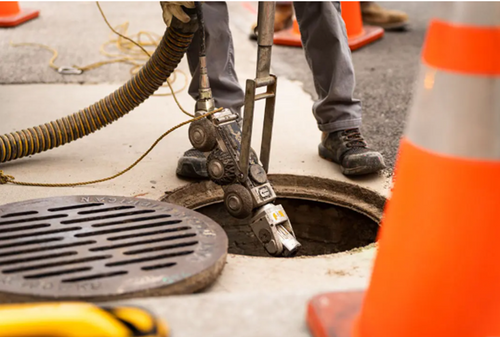Rent vs. Buy vs. Hire a Sewer Scope Service Provider: Video Pipe Inspection
Remote controlled video cameras, lateral launch or push cameras are just two ways VPI technology detects cracks, blockages, and system failures in sewer & lateral lines.

A CCTV video pipe inspection provides a comprehensive view of your sewer system, allowing you to visualize problems and proactively plan maintenance & repairs.
Only One Option Keeps Projects On Time, On Budget, and Safe
Aging and deteriorating sewer systems pose a significant risk to municipalities and commercial facilities. From structural failures to hazardous cross bores, these underground infrastructures are continuously at risk of damage. Identifying issues before they escalate is critical, and a proactive approach requires a thorough assessment, strategic planning, and timely remediation.
A CCTV video pipe inspection (VPI) offers an indispensable solution by delivering a detailed visualization of a facility’s sewer system. Utilizing high-definition video cameras mounted on remote-controlled robotic crawlers, lateral launch robots, or push cameras, VPI technology enables inspectors to detect cracks, blockages, and system failures within sewer, water, and lateral lines.
Evaluating the Best Approach
Facility managers face three options when incorporating VPI into their operations: renting inspection equipment, purchasing VPI technology, or outsourcing the process to experienced professionals. While renting or buying may seem cost-effective at first glance, a deeper analysis reveals substantial financial, technical, and operational drawbacks that make hiring an experienced VPI service provider the optimal choice.
Renting VPI Equipment
The rental route may initially appear to offer flexibility, but the associated costs and knowledge requirements often make it impractical. A standard CCTV pipe inspection system rents for approximately $1,000 per day, and facility teams must undergo proper training before operating these complex devices.
Basic VPI training courses typically cost $400 per trainee, conducted in a classroom environment with no real-world application until an active project begins. A technician must also understand how to interpret inspection results and compile actionable reports to inform mitigation and repair strategies.
"The National Association of Sewer Service Companies (NASSCO) is the gold standard for the standardized coding of pipe defects. This is supported by the fact that most insurers and municipalities now require NASSCO-certified inspections prior to groundbreaking on large-scale sewer and storm sewer projects."
— Callie H., Producer
NASSCO’s Pipeline Assessment Certification Program (PACP), Lateral Assessment Certification Program (LACP), and Manhole Assessment Certification Program (MACP) provide specialized training for assessing the condition of sewer infrastructure. Certification courses range from $925 and up, depending on project-specific needs.
Even before conducting a single inspection, renting requires an investment exceeding $2,300 in equipment and training, while simultaneously increasing the likelihood of errors in defect identification—leading to costly miscalculations and project delays.
Purchasing VPI Equipment
Investing in a dedicated VPI system appears to offer long-term savings, but the technical complexity and financial burden of ownership often outweigh the benefits. A standard VPI rig costs over $70,000, and with evolving inspection technology, systems become outdated within a few years.

A CCTV video pipe inspection provides a comprehensive view of your sewer system, allowing you to visualize problems and proactively plan maintenance & repairs.
Beyond initial purchase costs, facility managers must budget for ongoing equipment maintenance, software updates, and personnel training. Certification requirements remain mandatory, meaning an additional $925–$1,500 in training expenses must be factored into the total investment.
Ultimately, facility teams must allocate $73,000–$75,000 and three or more days of specialized training before executing a single inspection. The return on investment diminishes further when factoring in operational disruptions caused by misidentified defects or incomplete assessments.
Hiring a Professional Video Pipe Inspection Service Provider
Engaging an experienced VPI service provider ensures inspections are conducted with precision, efficiency, and regulatory compliance.
GPRS provides NASSCO-certified, industry-leading sewer inspection services, delivering comprehensive reports that include detailed defect descriptions, severity rankings, geolocation data, and high-resolution video documentation. With professionals handling the inspection process, facility managers eliminate unnecessary expenditures while accelerating project timelines.
Advanced technology further distinguishes professional services from in-house attempts. GPRS deploys the Envirosight Rovver X Mainline Crawler, an advanced sewer inspection system capable of reaching 1,000 feet from any access point. The SAT/Lateral Launch Camera Crawler specializes in navigating lateral sewer lines for high-risk cross bore inspections, while the Ridgid SeeSnake pushrod camera enables access through small cleanouts and vents.
By leveraging cutting-edge technology and expertise, GPRS ensures inspections meet NASSCO’s gold-standard protocols, safeguarding projects against unforeseen subsurface complications.
When facility managers attempt in-house inspections, the scope is limited to available resources and operational experience. By partnering with a professional VPI service such as GPRS, facilities gain access to elite technologies and expert consultation, streamlining utility assessments and reducing project risk.
With over an elite team of Project Managers across the United States, GPRS offers rapid response times, real-time data collection, and same-day inspection results, keeping commercial construction projects on time, on budget, and safe.
GPRS helps facilities Intelligently Visualize The Built World™.
What can we help you visualize?
